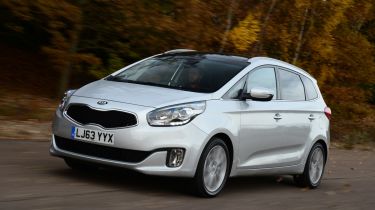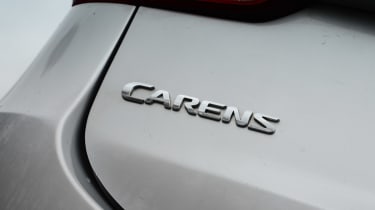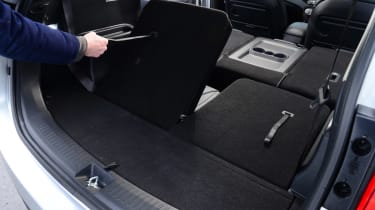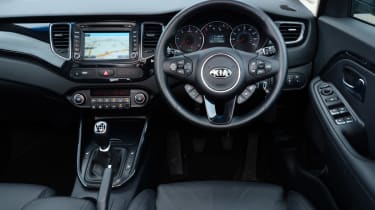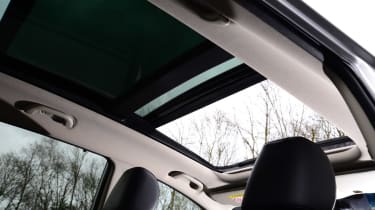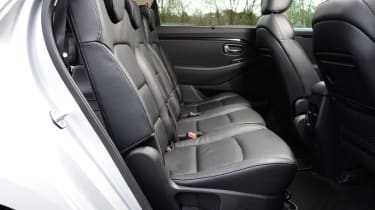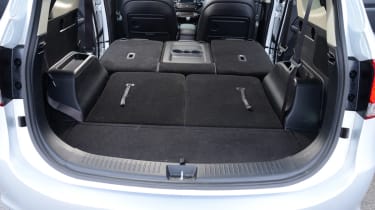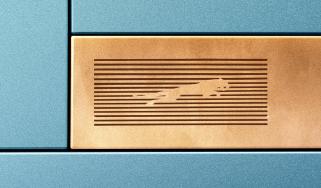Kia Carens review
Kia’s seven-seat Carens MPV is a low-key but capable option in the large MPV class

The Kia Carens has always flown under the radar in the seven-seat MPV market, especially with established rivals such as the Ford Grand C-MAX, Citroen Grand C4 Picasso and Renault Grand Scenic.
But while the first two generations of the model made no bones about their budget background, the latest model has aimed to change buyers’ perceptions, with stylish looks and technology borrowed from the Cee'd hatch.
The Carens is now Kia's largest MPV, despite having more compact dimensions than the Sedona it replaces. It’s certainly a more attractive visual proposition than the ageing Sedona and is the final car to receive Kia's upmarket new look, created by ex-Audi design chief Peter Schreyer.
If you want a bigger Kia with seven seats, you now have to look at the latest Sorento crossover. However, it’s considerably more expensive, with a near-£30k starting price. The Carens range starts from a little over £18k.
All Carens models sold in the UK get seven seats as standard. Two CRDi diesels and one petrol engine are available, but an automatic gearbox option is only available on the higher-powered diesel model.
The car comes in four trim levels, logically named 1, 2, 3 and 4, and as you’d expect from a budget brand still trying to make its mark they’re all pretty decently equipped.
More reviews
Car group tests
- Kia Carens - best people carriers and MPVs
- VW Golf SV vs Citroen C4 Picasso & Kia Carens
- Fiat 500L MPW vs Kia Carens
- Kia Carens vs rivals
In-depth reviews
Road tests
Used car tests
Standard features on the Carens 1 include LED daytime running lights, air conditioning, cruise control with speed limiter, flex steer – with normal, comfort and sport modes, all round electric windows and Bluetooth connectivity.
Move up to the Carens 2 and you get 16-inch alloy wheels, reversing sensors, automatic climate control, rain sensing wipers and electrically folding mirrors. The Carens 3 brings 17-inch alloys, a sat-nav system with a seven-inch infotainment touchscreen, reversing camera, power-adjustable driver’s seat and leather upholstery.
The range-topping Caren 4 adds a panoramic sunroof, parallel park assistance and an upgraded instrument cluster.
There’s a lot to be said for the seven-seater Kia Carens’ blend of style and versatility, especially if you’re looking for good-value pricing and cheap day-to-day running costs. Its contemporary design and high equipment levels make it a genuinely interesting alternative for MPV buyers.
Throw in a terrific reputation for reliability and some great independent crash test scores, and the Carens makes even more sense for families on a budget.
On the downside, it’s a little less spacious than some of its seven-seat rivals, and the performance and handling is somewhat mundane. Watch out for a large drop in value at resale time, too.
Engines, performance and drive
To get the higher-output 134bhp 1.7-litre diesel engine, you need to go for the flagship Carens 3. This engine still struggles to match the performance of its best seven-seat rivals, but it is an MPV and only feels overly sluggish when fully loaded.
In isolation, the Kia feels quick enough, but it is a heavy car and proves slower in-gear when compared with rivals such as the Fiat 500L MPW. Like other cars in the range, the Carens features an automatic-style step in its throttle pedal in order to promote economical driving, which needs a firm prod to get full power.
The rest of the driving experience is competent, but not particularly exciting. Kia offers the Carens with its Flex Steer system, which adjusts the weight according to which mode you select (Normal, Comfort or Sport) – although the changes in response are barely perceptible and not big enough for it to be a worthwhile addition. That’s partly because there’s not much steering wheel feedback, and while there’s plenty of grip and less body roll than most rivals in corners, you’d struggle to call the Carens exciting.
The Kia Carens is marginally quieter and more refined than the Fiat 500L MPW at motorway speeds, and it’s slightly smoother over rough roads. The car is equally capable at lower speeds, too.
Unfortunately, if you opt for the entry-level Carens, useful kit such as the reversing camera aren't even available as options - meaning parking will be that little bit trickier, especially as the small windows restrict visibility.
Engines
The 1.6-litre four-cylinder petrol engine in the Carens is smooth, but not particularly powerful at 133bhp – it’s slower even than the range-topping diesel. 0-62mph comes up in 10.9 seconds and top speed is 115mph.
The 1.7-litre four-cylinder diesel comes in two variants. The 114bhp model offers 0-62mph in 12.6 seconds, while the 134bhp 1.7 version does 0-62mph in 10.0 seconds and has a 119bhp top speed. The latter is the only one available with an automatic gearbox, but it saps acceleration, knocking more than a second and a half from the 0-62mph time.
MPG, CO2 and Running Costs
Kia prides itself on its ownership experience and there's no arguing with its industry-leading seven-year warranty. On top of this, the Care-3 fixed-price servicing package is conspicuously good value.
Three engines are available in the Carens, all of which come with stop-start as standard. However, while there are two CRDi diesel variants to choose from – both versions of the same 1.7-litre turbo diesel unit – economy and emissions are some way off the class best.
In 114bhp guise, the Kia Carens returns 61.4mpg and emits 120g/km, and we think this is the best all-round option unless you plan to tow a trailer or have all seven seats in regular use. If that's the case, the extra torque of the higher-powered diesel would come in handy, but otherwise its extra performance is of doubtful value in a car that isn’t set up to encourage spirited driving.
The 134bhp version manages 56.4mpg and 132g/km with a manual gearbox, or 46.3mpg and 159g/km with the auto, so the day-to-day running costs won’t be much higher – it’s more a question of whether it’s worth paying the extra up front.
The 133bhp 1.6-litre petrol engine is a little wheezy, but it’s smooth and quiet and manages 44.1mpg and 149g/km of CO2 – again, not class-leading figures, but if your mileage is relatively low it won’t have an too much impact on the finances.
Insurance groups
The 114bhp diesel is the least powerful Carens, and therefore should cost the least to insure. It sits in group 12, with the petrol-engined model in group 13. The 134bhp diesel is most expensive, falling into group 16.
Depreciation
Depreciation is definitely an issue here, with the Carens predicted to retain as little as 31.7 per cent of its original value over three years and 30,000 miles. This is a pretty painful result, especially for buyers who are looking at a supposedly ‘budget’ option.
Over the same ownership cycle, a Ford Grand C-Max should be worth at least 40 per cent of its new price, while a Volkswagen Touran should be closer to 50 per cent.
Interior, design and technology
The new Carens is much more stylish than its predecessor. It’s at least as interesting to look at as some of more conservative sector rivals such as the VW Touran or Vauxhall Zafira, but the Citroen Grand C4 Picasso, Peugeot 5008 and Renault Scenic have it beaten for style.
The Carens’ front will be familiar to Cee'd owners as it takes cues from the hatch, with Kia's distinctive grille and strips of LED running lights in the headlamps.
In fact, there’s more than a hint of Cee’d in the rest of the Carens’ design. The biggest difference between the two cars is the greater expanse of metal between the wheelarches and lower window line. It's a coherent design, although entry-level 1 versions make do with just steel wheels and plastic trims, which lower the tone a notch compared to versions higher up the pecking order.
Inside, the Carens feels solid and very well built, but the design feels rather uninspiring. This is especially the case for entry-level 1 models which have a rather utilitarian feel and make do without the gloss black trim, panoramic sunroof and touchscreen multimedia system of higher-spec 3 Nav cars.
Black plastic is used throughout, with a few minor strips of silver trim on the wheel, dials and vents.
Still, the cabin is well laid out and solid switchgear throughout feels like it'll last.
Sat-nav, stereo and infotainment
All versions of the Carens are fitted with a six-speaker radio/CD player with steering-wheel controls, plus USB and Bluetooth connectivity for music-streaming and hands-free phone calls.
On the more luxurious trim-level 3 and 4 models, you get a seven-inch touchscreen that includes a sat-nav, plus a reversing camera. The screen is also used for the trim-level 4 model’s parallel park assist feature.
Practicality, comfort and boot space
Despite a lack of space when compared with some of its rivals, the car features a functional and well-packaged cabin.
While the Carens trim level 1 feels a bit basic, the better-equipped versions are certainly pleasant enough to live with. Standard kit includes practical features such as Bluetooth, a reversing camera, window blinds and a cooled glovebox. If you have the panoramic sunroof, it floods the cabin with light and opens at the touch of a button.
There are plenty of cubbyholes throughout the cabin, including two under the feet of middle-row passengers and a large centre bin. The front seatbacks are fitted with map nets and trays, plus when you fold the central seat in the second row, there's a wipe clean back and a pair of useful cup-holders.
Size
In this class interior space is key, so it seems a little odd that the latest Carens is 20mm shorter, 15mm narrower and 45mm lower than its predecessor.
However, by shifting the front pillars of the car forwards over the front wheels and stretching the distance between the axles by 50mm, Kia has actually made the interior bigger.
But it's still not enough to stop the Carens feeling noticeably smaller than the leading seven-seat rivals on the market. At 4,525mm it’s shorter than both the 4,656mm Vauxhall Zafira and 4,597mm Citroen Grand C4 Picasso.
Leg room, head room & passenger space
Middle-row legroom is a bit tight, but as you'd expect, all three seats slide and fold individually, allowing you to vary the space on offer across the car.
All Carens models sold in the UK come with seven seats, but the two rear seats are for occasional use only. They're a little tricky to get in and out of, while head, leg and foot room are in short supply. Fortunately, the seats fold easily into the boot floor with the pull of a canvas strap.
All seat operations are slick and easy to work - something crucial for family life.
Boot
Given the Carens' more compact dimensions, it's no surprise that the 492-litre boot is smaller than many rivals. On the plus side, the front passenger seat folds flat at the pull of a lever and even with all seven seats in place there's still 100 litres of luggage capacity to play with.
There's a 12V socket in the boot and a light that doubles as a removable torch, plus enough space under the floor for the luggage cover, which has carpeted ends to prevent any scratches.
Reliability and Safety
Most of the technology, engines and gearbox featured across the Carens line-up are already proven in other Kia models. The Carens uses much of the same running gear as the Cee’d hatch - so you can expect it to run like clockwork.
Kia has a strong reputation for reliability generally, which is why the brand feels able to offer a seven-year warranty that covers most major parts.
Kia’s network finished 14th out of 31 in our Driver Power 2015 dealer survey too, so if something does go wrong you have a reasonable chance of being treated in a satisfactory fashion.
While the Carens didn’t make it into the most recent Driver Power survey, the previous generation Cee’d performed strongly – ranking 38th for overall satisfaction out of 200 cars, with reliability ranked 64th and build quality 56th.
We’d be surprised if those results aren’t mirrored or even bettered by the Carens, as it certainly has a durable and well put-together feel.
The Carens comes with six airbags, full three-point seatbelts and adjustable headrests for all seven seats, plus electronic stability control. As a result of that – plus some obviously sound engineering - the Carens earned a five-star overall rating in the independent EuroNCAP crash test in 2013. Its test results included a 94 per cent rating for adult occupant safety and 74 per cent for child seat occupants, and NCAP considered the Carens to be best in its class in 2013.
In 2015. the Volkswagen Touran scored 88/89 per cent for adult/child safety and the Ford S-Max scored 87/87 per cent.
Warranty
All cars get Kia's impressive seven-year, 100,000-mile transferable warranty, which has now been extended to also include seven years of free map updates for cars with factory-fitted sat-nav systems. You simply won’t find a better standard warranty offer than that.
Servicing
Service intervals for the Carens are 12 months or 20,000 miles, and there are very affordable service plans that allow you to spread the cost monthly.
Kia Care-3 and Care-3 Plus fix the cost of the first three or five services for £329 inclusive or £609, as well as discounting the cost of the first MoT test, so are well worth a look.
